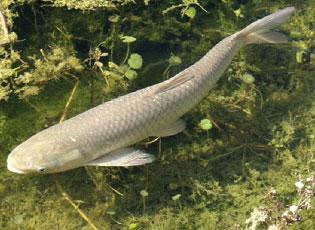Ctenopharyngodon idella (Valenciennes in Cuvier and Valenciennes, 1844) (ITIS)
Grass carp, white amur
Eastern Asia (NAS Database)
1963 (NAS Database)
Imported for aquaculture and for phytoplankton control (NAS Database)
Direct and indirect impacts via: competition for food; significant changes in the composition of macrophyte, phytoplankton, and invertebrate communities; interference with the reproduction of other fishes; decreases in refugia for other fishes; modification of preferred habitat; predation or competition when plant food is scarce. Has significantly altered the food web and trophic structure of aquatic systems by inducing changes in plant, invertebrate, and fish communities (NAS Database)

Grass carp, adult
Photo by Pam Fuller; U.S. Geological Survey
Find more images
Spotlights
Distribution / Maps / Survey Status
Federally Regulated
Videos
All Resources
Selected Resources
The section below contains highly relevant resources for this species, organized by source.
Council or Task Force
Partnership
Federal Government
International Government
State and Local Government
Academic
Professional
Integrated Taxonomic Information System. Ctenopharyngodon idella. [Accessed Sep 16, 2023].
Nonindigenous Aquatic Species Database. Fact Sheet - Grass Carp. USGS, Gainesville, FL. [Accessed Sep 16, 2023].
